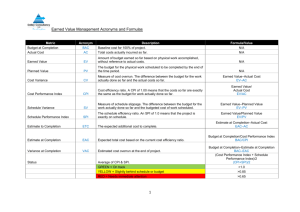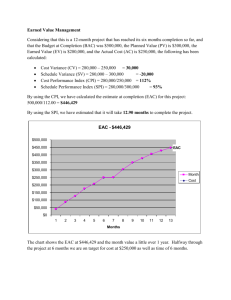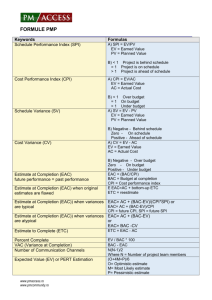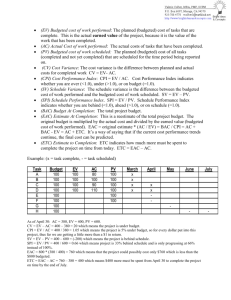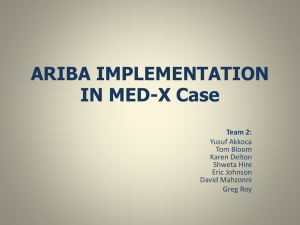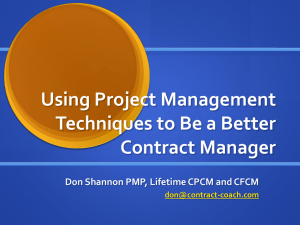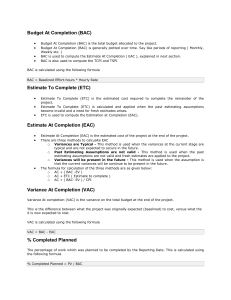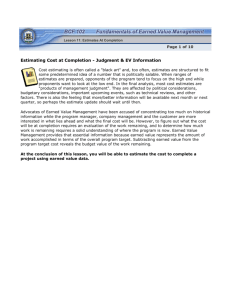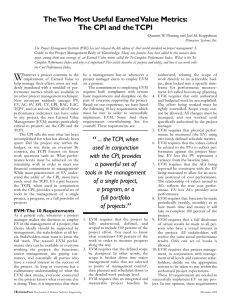Module 13: Control Project Performance
advertisement
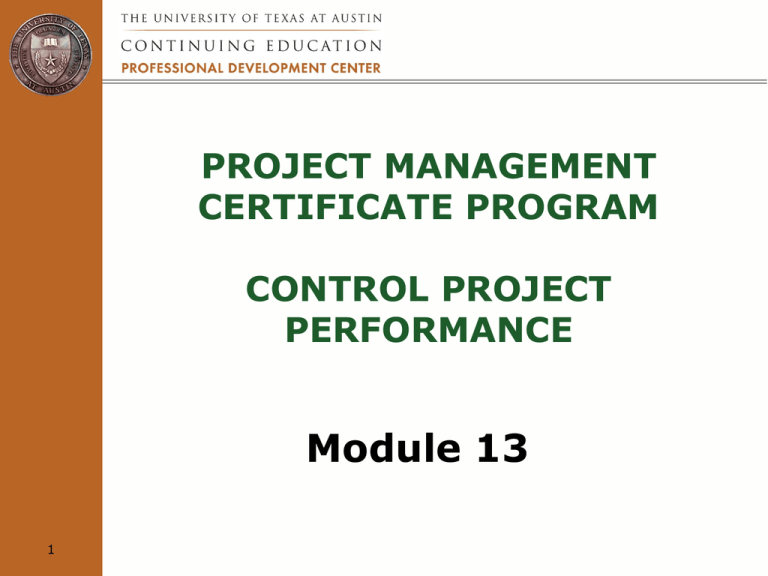
PROJECT MANAGEMENT CERTIFICATE PROGRAM CONTROL PROJECT PERFORMANCE Module 13 1 2 Module Objectives By module end, you will be able to: • Understand how performance is managed on the project • Understand the purpose for monitoring and managing performance closely • Understand what tools will be used to manage project performance 3 Control Project Performance In Control Project Performance, the project manager will: • Continue to manage project work • Focus on controlling the project performance 4 Control Project Performance In Control Project Performance, 4 PMBOK processes are used: • • • • 5 Report Performance Verify Scope Perform Quality Control Monitor & Control Project Work Report Performance 6 • Communications process of providing project stakeholders with performance information, through status reporting, progress reporting and forecasting • The level and detail of reporting should be appropriate to the intended audience. • Many times, performance reports rely heavily on earned value analysis, presented in the form of bar charts, Scurves, histograms and/or spreadsheets. Report Performance This process collects and distributes status reports and forecasts Inputs Variance Analysis Performance Reports Plan Forecasting Methods Organizational Process Communication Work Performance Work Performance Measurements Organizational Process Assets Outputs Project Management Information Tools and Techniques Budget Forecasts 7 Methods Reporting Systems Assets Updates Change Requests Report Performance Think about the practical application of this process: • • • • 8 Process Documents Document Templates Process Tasks Think About It Exercise MUST KNOW CONCEPTS 9 EARNED VALUE 10 Four Key Data Points • • • • 11 Planned Value Earned Value Actual Cost Budget at Completion Planned Value • Planned Value (PV = Budgeted Cost of Work Scheduled = BCWS) • The budget that has been authorized for work scheduled that is to be completed for a scheduled activity or WBS component. 12 Earned Value • Earned Value (EV = Budgeted Cost of Work Performed - BCWP) • The value received/recognized for the expense or use of approved funds/hours in order to complete scheduled work or WBS element(s). 13 Actual Cost • Actual Cost (AC = Actual Cost of Work Performed = ACWP) • Cost incurred for completed work (EV) during a given time period. 14 Schedule Variance 15 • Schedule Variance Example: – In a 3 day period, we planned to complete 24 hours of work at $100/hr. The value of the work we planned to complete is $2,400 . – At the end of 3 days we have completed 18 hours of work at $100/hr. The means we have earned $1,800 hours worth of the work. The actual cost is $1,800.00. – SV = $1,800 - $2,400 = ($600) Cost Variance 16 • Cost Variance Example: – In a 3 day period, we planned to complete 24 hours of work at $100/hr. The value of the work we planned to complete is $2,400. – At the end of 3 days we have completed 18 hours of work at $100/hr. The means we have earned $1,800 worth of the work. The actual cost is $1,800.00. – CV = $1,800 - $1,800 = ($0) Cost Performance Index 17 • Cost Performance Index is a measure of our cost efficiency. It is a ratio of Earned Value to Actual Cost. • For every dollar we spend, how much work (in dollars) do we receive? • CPI = EV/AC • If the value is greater than 1, we have a favorable CPI. • If the value is less than 1, we have an unfavorable CPI. Using Earned Value – CPI involves taking a measurement of the project at a specific point in the project – like a stake in the ground… Measurement Point PV = $42,000 Begin Project CPI < 1.0 “BAD” CPI > 1.0 “GOOD” CPI = 1.0 “PERFECT” If the conditions is 18 PV = $42,000 EV = $40,000 AC = $45,000 End Project Total Project BAC = $70,000 Using Earned Value – CPI involves taking a measurement of the project at a specific point in the project – like a stake in the ground… Measurement Point PV = $42,000 Begin Project CPI < 1.0 “BAD” CPI > 1.0 “GOOD” CPI = 1.0 “PERFECT” If the conditions is PV = $42,000 EV = $40,000 AC = $45,000 CPI = .888 19 End Project Total Project BAC = $70,000 Schedule Performance Index 20 • Schedule Performance Index measures our schedule efficiency. It is a ratio of Earned Value to Planned Value. • For every time unit we spend, how many time units of work do we receive? • SPI = EV/PV • If the value is greater than 1, we have a favorable SPI. • If the value is less than 1, we have an unfavorable SPI. Using Earned Value – SPI involves taking a measurement of the project at a specific point in the project – like a stake in the ground… Measurement Point PV = $42,000 Begin Project SPI < 1.0 “BAD” SPI > 1.0 “GOOD” SPI = 1.0 “PERFECT” If the conditions is PV = $42,000 EV = $40,000 SPI = .9523 21 End Project Total Project BAC = $70,000 Additional Calculations • Estimate to Complete (ETC) • Estimate at Complete (EAC) • Variance at Complete (VAC) 22 Estimate to Complete • Estimate to Complete = The expectation of what is needed to complete the work remaining on a scheduled activity/WBS element, etc. • More simply, how much still has to be done. • This is done when evaluating and making revisions on your estimates for project cost and/or time. 23 Estimate to Complete - 1 24 • ETC = BAC - EV • Example: – In our schedule, we planned to have $800 worth of work completed in 1 day. – Halfway through the day, we have completed only or $200 worth of work. – We have $600 of the work remaining to complete during the day. – ETC = $800 - $200 = $600 Estimate to Complete - 2 25 • Halfway through the day we have spent $400 to complete $200 worth of work. • CPI = EV/AC = $200/$400 = .5 (over budget) • ETC = (BAC-EV)/CPI • ETC = ($800 - $200)/.5 • ETC = $600/.5 = $1,200 • It will cost us $1,200 to complete the project. Estimate at Completion 26 • Estimate at Completion is the expected total cost for completing a project, scheduled activity, WBS item, etc. • It represents the actual cost to date plus the Estimate to Complete • EAC with new estimate – EAC = AC + ETC • EAC = $200 + $600 = $800 Estimate at Completion - 1 • • • • 27 EAC EAC EAC EAC with remaining budget = AC + BAC - EV = $400 + $800 - $200 = $1,000 Estimate at Completion - 2 • Halfway through the day we have spent $400 to complete $200 worth of work. • CPI = EV/AC = $200/$400 = .5 (over budget) • EAC = AC + ((BAC-EV)/CPI) • EAC = $400 + (($800 - $200)/.5) = $400 + (600/.5) = $400 + $1200 = $1600 28 Variance at Completion • Variance at Completion forecasts what the final cost variance will be when the work is completed. • If the VAC is >=0, then we are under budget. • If the VAC is <=0, then we are over budget. • VAC = BAC - EAC • VAC = $800 - $1,600 = - $800 29 TCPI: To Complete Performance Index • TCPI (based on BAC): TCPI = (BAC – EV / (BAC – AC). TCPI based on BAC is the forecast of how efficient future project performance must be in order to conform to the planned BAC for the project. • BAC= $3,000 • EV= $2,000 • AC = $2,400 • TCPI = 30 ($3,000 - $2,000) / ($3,000 - $2,400) or ($1,000) / ($600) = 1.666 TCPI: To Complete Performance Index • TCPI (based on EAC): TCPI = (BAC – EV / (EAC – AC). TCPI based on EAC is the forecast of how efficient future project performance must be in order to conform to the planned EAC (based on new outcome predictions) for the project. • • • • 31 BAC= $3,000 EV= $2,000 AC = $2,400 EAC = $3,400 • TCPI = • ($3,000 - $2,000) / ($3,400 - $2,400) or ($1,000) / ($1,000) = 1.0 MUST KNOW CONCEPTS 32 Verify Scope • Obtaining formal acceptance of project deliverables • Project deliverable is not complete until it has been formally accepted • Formal acceptance must be documented 33 Verify Scope This process formalizes acceptance of completed project deliverables Inputs Project Management Plan Requirements Documentation Requirements Traceability Matrix 34 Tools and Techniques Inspection Outputs Accepted Deliverables Change Requests Project Document Updates Verify Scope Think about the practical application of this process : • • • • Process Documents Document Templates Process Tasks Think About It Exercise MUST KNOW CONCEPTS 36 Perform Quality Control • Process of monitoring specific project results to ensure they comply with the project’s quality standards • Also intended to identify ways to eliminate quality problems such as causes of weak processes or poor product quality 37 Perform Quality Control • Quality control monitors both product-related deliverables (work packages) and project management deliverables (cost/schedule/scope performance). • This process focuses on outputs and uses tools that measure these outputs. 38 Perform Quality Control This process monitors project results against relevant quality standards Inputs Project Management Tools and Techniques Plan Quality Metrics Quality Checklists Work Performance Cause and Effect Outputs Diagrams Quality Control Measurements Control Charts Validated Changes Flowcharting Validated Deliverables Histogram Change Requests Approved Change Pareto Chart Organizational Process Requests Run Chart Deliverables Scatter Diagram Organizational Process Statistical Sampling Inspection Approved Change Measurements Assets Request Review 39 Assets Updates Project Management Plan Updates Project Document Updates Run Chart Example 40 Time Delivery Time Day of Week U S F W M S TH T U S F W 40 35 30 25 20 15 10 5 0 M 15 17 15 18 21 25 28 16 18 19 14 17 26 31 32 15 14 17 35 38 27 Minutes Date M T W TH F S SU M T W TH F S SU M T W TH F S SU Scatter Diagram Example 1 2 2 2 3 3 3 4 4 4 5 5 5 6 6 7 7 8 8 8 41 Value 40,000 33000 30,000 29,000 29,000 28,000 25,000 26,000 23,000 22,000 20,000 19,000 18,000 15,000 14,000 13,000 9,000 10,000 8,000 6,000 Car Age/Value Value Age 45,000 40,000 35,000 30,000 25,000 20,000 15,000 10,000 5,000 0 0 2 4 Age of Car 6 8 10 Perform Quality Control Think about the practical application of this process : • • • • Process Documents Document Templates Process Tasks Think About It Exercise MUST KNOW CONCEPTS 43 Monitor & Control Project Work • Monitor all other processes through initiation, planning, executing and closing • Take/make corrective/preventive actions • It is the project manager’s responsibility to continuously monitor project work 44 Monitor and Control Project Work This process monitors and controls the processes used by the team Inputs Project Management Plan Performance Reports Enterprise Environmental Factors Organizational Process Assets 45 Tools and Techniques Expert Judgment Outputs Change Requests Project Management Plan Updates Project Document Updates Monitor & Control Project Work Think about the practical application of this process : • Process Documents • Document Templates • Process Tasks • Think About It Exercise MUST KNOW CONCEPTS 47 MODULE REVIEW


